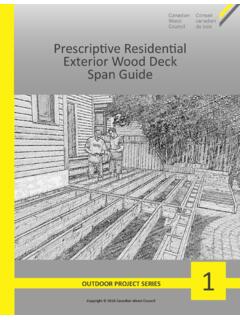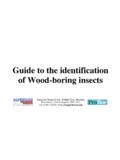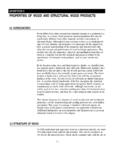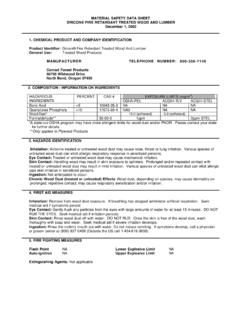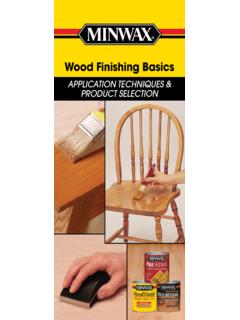Transcription of Saskatchewan Invasive Plant Species Identification …
1 Invasive Plant Species Identification GuideSaskatchewanLEGENDP lant ShapeNarrow with drooping seed headLow & spreadingNot branchedSlightly branchedBranchedHighly branchedShrub or treeMulti-stemmedRosette in seedling yearRosetteSaskatchewan Invasive Plant Species Identification guide 1 IntroductionThis guide is to be used as a tool to help identify Invasive Plant Species in Saskatchewan . An Invasive Plant Species is a non-native Plant that, because of its growth and reproductive characteristics, can adapt to one or more habitats very quickly and proliferate, expanding in range. An Invasive Plant Species has a negative economic, eco-logical, and/or aesthetic Invasive Plant Species Identification guide for Saskatchewan has been designed for agricultural producers, land managers, and visitors to Saskatchewan .
2 Producers and land managers play an important role in Invasive Species manage-ment as they are on the ground everyday, acutely aware of changes on the landscape. Visitors to the area often have a keen eye for the vegetation they are seeing. Visitors need to be aware of the threat Invasive Species pose so that these plants are not brought into, spread around or transported out of the Species are a growing threat to the integrity of native prairie. Native prairie is home to many important and/or rare plants and animals. The plants which make up native prairie work together to store carbon, maintain water and nutrient cycling, and build soil.
3 Invasive Species can upset this invasion of non-native Species in haylands, tame forage, gravel pits, riparian areas, road-sides and cropland affect the function of these habitats and can cause a downgrade in their usefulness. IntroductionInvasive Plant Species Identification GuideSaskatchewanSaskatchewan Invasive Plant Species Identification guide 2 All of the Species included in this guide are a threat to of Invasive Species is the most cost effective and environmentally responsible management tool. Do not transport hay, soil, or plants from an area with known infestations to an uninfested area. Most Invasive Species require some bare ground to establish.
4 Keeping permanent cover in a healthy range condi-tion minimizes the amount of habitat an Invasive Species can colonize. Control new infestations in cultivated fields when they are first noticed. Wash or check clothing, pets, horses, livestock, equipment and vehicles for Plant parts or seeds before coming into or leaving a new area. Early Identification increases the chances of eradication. Take the time to identify that Plant that looks out of place, you ve never seen before, or has suspiciously shown up. It could save you or your neighbours time and money in the long run! Some of the Invasive plants in this guide have not yet been identified in Saskatchewan , or have only been noted in very isolated populations.
5 They have been included in this guide so that if they are present, a rapid Identification and control can take place prior to an exponential invasion. If you identify one of these Invasive plants contact the Provincial Weed Control Specialist at not-yet locally identified or uncommon Species include: Yellow star thistle, Field scabious, Purple loosestrife, Salt cedar, Spotted knapweed, Russian knapweed, Diffuse knapweed, African rue, Hoary cress/White top, and Orange you identify an Invasive Plant Species consult with your local Rural Municipality, your local Weed Management Area, a certified Agronomist or Agrologist, or the Saskatchewan Ministry of Agriculture Agricultural Knowledge Centre at Invasive Plant Species Identification guide 3 Plant Shapes.
6 4 Diagrams of Plant Parts ..5 Plant Species Listings ..7 Grasses Downy brome - Bromus tectorum ..8 Japanese brome - Bromus japonicus ..9 Yellow Flowered plants Absinthe wormwood - Artemisia absinthium ..10 Common tansy - Tanacetum vulgare ..11 Dalmatian toadflax - Linaria dalmatica ..12 Yellow toadflax - Linaria vulgaris ..13 Leafy spurge - Euphorbia esula ..14 Yellow star thistle - Centaurea solstitialis ..15 Purplish Flowered plants Bull thistle - Cirsium vulgare ..16 Canada thistle - Cirsium arvense ..17 Nodding thistle - Carduus nutans ..18 Field scabious - Knautia arvensis ..19 Purple loosestrife - Lythrum salicaria ..20 Dames Rocket - Hesperis matronalis.
7 21 Pink Flowered plants Common burdock - Arctium minus subsp. minus ..22 Salt cedar - Tamarix spp ..23 Spotted knapweed - Centaurea maculosa ..24 Russian knapweed - Acroptilon repens ..25 White Flowered plants Diffuse knapweed - Centaurea diffusa ..26 African rue - Peganum harmala ..27 Baby s breath - Gypsophila paniculata ..28 Field bindweed - Convolvulus arvensis ..29 Hoary cress or white top - Cardaria draba ..30 Round-leaved mallow - Malva pusilla or Malva rotundifolia ..31 Scentless chamomile - Matricaria perforata ..32 Hoary alyssum - Berteroa incana ..33 Ox-eye daisy - Chrysantheum leucanthemum ..34 Orange/Red Flowered plants Orange hawkweed - Hieracium aurantiacum.
8 35 Glossary ..36 Table of ContentsTable of ContentsSaskatchewan Invasive Plant Species Identification guide 4 Plant ShapesRosetteRosette in seedling yearMulti-stemmedShrub or treeHighly branchedBranchedSlightly branchedNot branchedLow & spreadingNarrow with drooping seed headPlant ShapesThe shape of a Plant can be used as a distinguishing characteristic setting it apart from other plants . Some plants can have more than one shape depending on their life cycle, habitat, or the climate. Saskatchewan Invasive Plant Species Identification guide 5 Grass Plant PartsLeaf PartsDiagrams of Plant PartsPlant PartsSaskatchewan Invasive Plant Species Identification guide 6 Types of Divided LeavesShapes of Simple LeavesLinearLanceolateOblanceolateOblong EllipticalOvalOvateObovateSpatulateCunea te(Wedge-shaped)Deltoid(Triangular)Corda te(Heat-shaped)Reniform(Kidney-shaped)Or bicular(Circular)Peltate(Shield-shaped)
9 PinnatelyLobedPinnatelyDividedPalmatelyL obedPalmatelyDividedPalmatelyMuch DividedOdd pinnateEven pinnateInterruptedlypinnateCompound pinnateTrifoliolateDigitateSaskatchewan Invasive Plant Species Identification guide 7 Plant Species ListingsPlant Species ListingsPlant Species may be listed as noxious weeds in one or more jurisdictions when they are Invasive and pose a threat of invasion, rapid spread and dif-ficulty in control. It is important to be aware of Invasive Species in adjoining jurisdictions as the threat from neighbouring areas may be determine the Species listing of any Invasive Plant Species in your area, please contact your local RM or the Saskatchewan Ministry of AgricultureSaskatchewan Invasive Plant Species Identification guide 8 Downy BromeAlso Known As: cheatgrass, thatch bromegrass, early chess, downy chessGeneral Description: hairy, purplish tinged winter or summer annual grass with fibrous roots; often growing in dense patches; seed spikelets droop to one sideLeaves: to 6 inches ( to cm) long, green.
10 Soft hairs on the top and bottom of leaf; lacks auricles, but has a jagged to inch ( to mm) long hairless liguleStems: slender, upright, hairy; leaf sheath has long hairs; often purplish tingedHeight: 3 to 24 inches ( to 61 cm) tall Flower: drooping, spreading spike-lets (of 4 or more seeds) on slender twisting branches; droops to one side; rough to inch ( to cm) long straight to slightly bent awns; purplish tingedHabitat: tame forage, native prairie, yard sites, cropland, waste areas & roadsidesTime of Flowering: heads out in May through June with seed set shortly thereafterKey Distinguishing Characteristic(s): similar to Japanese brome (Bromus japonicus) - distinguishable by smaller seeds, lack of silky hairs on the ligule, straight to slightly bent awns and a more spreading appearance of the drooping seed headsImpact: displaces native vegetation, reduces crop yields and increases risks of wildfire.



